Disease-linked connexin26 S17F promotes volar skin abnormalities and mild wound healing defects in mice
- PMID: 28569788
- PMCID: PMC5520893
- DOI: 10.1038/cddis.2017.234
Disease-linked connexin26 S17F promotes volar skin abnormalities and mild wound healing defects in mice
Erratum in
-
Correction to: Disease-linked connexin26 S17F promotes volar skin abnormalities and mild wound healing defects in mice.Cell Death Dis. 2018 May 24;9(6):630. doi: 10.1038/s41419-018-0639-1. Cell Death Dis. 2018. PMID: 29795380 Free PMC article.
Abstract
Several mutant mice have been generated to model connexin (Cx)-linked skin diseases; however, the role of connexins in skin maintenance and during wound healing remains to be fully elucidated. Here we generated a novel, viable, and fertile mouse (Cx26CK14-S17F/+) with the keratitis-ichthyosis-deafness mutant (Cx26S17F) driven by the cytokeratin 14 promoter. This mutant mouse mirrors several Cx26-linked human skin pathologies suggesting that the etiology of Cx26-linked skin disease indeed stems from epidermal expression of the Cx26 mutant. Cx26CK14-S17F/+ foot pad epidermis formed severe palmoplantar keratoderma, which expressed elevated levels of Cx26 and filaggrin. Primary keratinocytes isolated from Cx26CK14-S17F/+ neonates exhibited reduced gap junctional intercellular communication and migration. Furthermore, Cx26CK14-S17F/+ mouse skin wound closure was normal but repaired epidermis appeared hyperplastic with elevated expression of cytokeratin 6. Taken together, we suggest that the Cx26S17F mutant disturbs keratinocyte differentiation and epidermal remodeling following wound closure. We further posit that Cx26 contributes to epidermal homeostasis by regulating keratinocyte differentiation, and that mice harboring a disease-linked Cx26 mutant display epidermal abnormalities yet retain most wound healing properties.
Conflict of interest statement
The authors declare no conflict of interest.
Figures
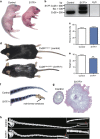


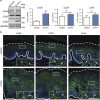

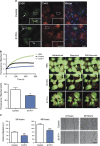
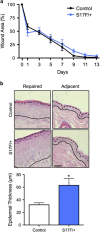
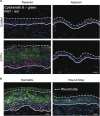
Similar articles
-
The Cx26-G45E mutation displays increased hemichannel activity in a mouse model of the lethal form of keratitis-ichthyosis-deafness syndrome.Mol Biol Cell. 2011 Dec;22(24):4776-86. doi: 10.1091/mbc.E11-09-0778. Epub 2011 Oct 26. Mol Biol Cell. 2011. PMID: 22031297 Free PMC article.
-
The connexin26 S17F mouse mutant represents a model for the human hereditary keratitis-ichthyosis-deafness syndrome.Hum Mol Genet. 2011 Jan 1;20(1):28-39. doi: 10.1093/hmg/ddq429. Epub 2010 Oct 6. Hum Mol Genet. 2011. PMID: 20926451
-
Aberrant hemichannel properties of Cx26 mutations causing skin disease and deafness.Am J Physiol Cell Physiol. 2007 Jul;293(1):C337-45. doi: 10.1152/ajpcell.00626.2006. Epub 2007 Apr 11. Am J Physiol Cell Physiol. 2007. PMID: 17428836
-
Connexin-26 mutations in deafness and skin disease.Expert Rev Mol Med. 2009 Nov 19;11:e35. doi: 10.1017/S1462399409001276. Expert Rev Mol Med. 2009. PMID: 19939300 Review.
-
Connexins: sensors of epidermal integrity that are therapeutic targets.FEBS Lett. 2014 Apr 17;588(8):1304-14. doi: 10.1016/j.febslet.2014.02.048. Epub 2014 Mar 4. FEBS Lett. 2014. PMID: 24607543 Review.
Cited by
-
Mapping O2 concentration in ex-vivo tissue samples on a fast PLIM macro-imager.Sci Rep. 2020 Nov 4;10(1):19006. doi: 10.1038/s41598-020-75928-3. Sci Rep. 2020. PMID: 33149165 Free PMC article.
-
Inner Ear Connexin Channels: Roles in Development and Maintenance of Cochlear Function.Cold Spring Harb Perspect Med. 2019 Jul 1;9(7):a033233. doi: 10.1101/cshperspect.a033233. Cold Spring Harb Perspect Med. 2019. PMID: 30181354 Free PMC article. Review.
-
Assessment of Gap Junction Protein Beta-2 rs3751385 Gene Polymorphism in Psoriasis Vulgaris.J Clin Med Res. 2019 Sep;11(9):642-650. doi: 10.14740/jocmr3845. Epub 2019 Sep 1. J Clin Med Res. 2019. PMID: 31523338 Free PMC article.
-
Connexins in Astrocyte Migration.Front Pharmacol. 2020 Jan 15;10:1546. doi: 10.3389/fphar.2019.01546. eCollection 2019. Front Pharmacol. 2020. PMID: 32009957 Free PMC article. Review.
-
Comparative Analysis of Cx31 and Cx43 in Differentiation-Competent Rodent Keratinocytes.Biomolecules. 2020 Oct 14;10(10):1443. doi: 10.3390/biom10101443. Biomolecules. 2020. PMID: 33066499 Free PMC article.
References
-
- Alexander DB, Goldberg GS. Transfer of biologically important molecules between cells through gap junction channels. Curr Med Chem 2003; 10: 2045–58. - PubMed
-
- Avshalumova L, Fabrikant J, Koriakos A. Overview of skin diseases linked to connexin gene mutations. Int J Dermatol 2014; 53: 192–205. - PubMed
-
- Martin PE, van Steensel M. Connexins and skin disease: insights into the role of beta connexins in skin homeostasis. Cell Tissue Res 2015; 360: 645–58. - PubMed
MeSH terms
Substances
Grants and funding
LinkOut - more resources
Full Text Sources
Other Literature Sources
Medical
Molecular Biology Databases
Miscellaneous

